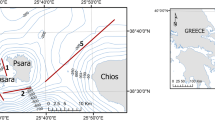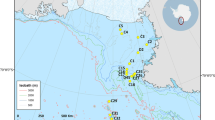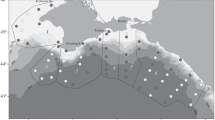Abstract
The fish at sites located throughout the large, seasonally closed Wilson Inlet, on the southern coast of Western Australia, were sampled bimonthly between September 1987 and April 1989. Seine nets were used to sample nearshore shallow waters, while gill nets were employed in slightly more offshore and deeper waters. Twenty species were recorded in the shallows, of which the three species of atherinid and the three species of goby comprised >97% of the total catch. In terms of number of individuals, the 27 species recorded in gill nets in the deeper waters were dominated by Cnidoglanis macrocephalus and Platycephalus speculator, and to a lesser extent Engraulis australis, Aldrichetta forsteri, Sillaginodes punctata and Arripis georgianus. Fifty-five percent of the species recorded in the nearshore shallow waters and 18% of those in offshore deeper waters spawn within Wilson Inlet; these species contributed 98.5 and 63.0%, respectively, to the total catches in those waters. Classification and ordination showed that the composition of the fauna in the shallows was similar at all sites throughout the large basin and did not change conspicuously with season. However, the composition of catches taken in offshore waters differed between the lower part of the basin and the middle and upper regions of the basin, which in turn differed from those in the saline reaches of a tributary river. The four diagnostic species of the lower estuary were all marine species, while the three diagnostic species in the river included a marine species (Mugil cephalus) that often penetrates far upstream in other systems, and a species which was confined to the rivers (Acanthopagrus butcheri). The composition of the fish fauna in the offshore waters of the lower estuary between the middle of spring and middle of autumn was different in 1987/1988 (when the estuary mouth was open for only the first two months of that period) from that in 1988/1989 (when the mouth was open for the whole of that period). This difference is related to the greater number of marine species that were retained in the first of these years, when the estuary was open to the ocean for only a short period. The greater retention of marine species in 1987/1988 than in 1988/1989 probably reflects a far lower level of freshwater flusing and/or a less marked decline in salinity.
Similar content being viewed by others
Literature cited
Belbin, L. (1988). PATN. Pattern analysis package. CSIRO Division of Wildlife and Rangelands Research, Canberra
Bennett, B. A. (1989). A comparison of the fish communities in nearby permanently open, seasonally closed and normally closed estuaries in the south-western cape, South Africa. S. Afr. J. mar. Sci. 8: 43–55
Bennett, B. A., Hamman, K. C. D., Branch, G. M., Thorne, S. C. (1985). Changes in the fish fauna of the Bot River Estuary in relation to opening and closure of the estuary mouth. Trans. R. Soc. S. Afr. 45: 449–464
Bird, E. C. F. (1984). Coasts. An introduction to coastal morphology. Australian National University Press, Canberra
Blaber, S. J. M., Whitfield, A. K. (1977). The feeding ecology and relative abundance of mullet (Mugilidae) in Natal and Pondoland estuaries. Biol. J. Linn. Soc. 9: 259–275
Chubb, C. F., Potter, I. C., Grant, C. J., Lenanton, R. C. J., Wallace, J. (1981). Age structure, growth rates and movements of sea mullet, Mugil cephalus L., and yellow-eye mullet, Aldrichetta forsteri (Valenciennes), in the Swan-Avon river system, Western Australia. Aust. J. mar. Freshwat. Res. 32: 605–628
Claridge, P. N., Potter, I. C., Hardisty, M. W. (1986). Seasonal changes in movements, abundance, size composition and diversity of the fish fauna of the Severn Estuary. J. mar. biol. Ass. U.K. 66: 229–258
Dando, P. R. (1984). Reproduction in estuarine fish. In: Potts, G. W., Wootton, R. J. (eds.) Fish reproduction strategies and tactics. Academic Press, London, p. 155–170
Day, J. H. (1981). Estuarine currents, salinities and temperatures. In: Day, J. H. (ed.) Estuarine ecology with particular reference to southern Africa. A. A. Balkema, Rotterdam, p. 27–44
De Decker, H. P., Bennett, B. A. (1985). A comparison of the physiological condition of the southern mullet Liza richardsoni (Smith), in a closed estuary and the sea. Trans. R. Soc. S. Afr. 45: 427–436
Field, J. G., Clarke, K. R., Warwick, R. M. (1982).A practical strategy for analysing multispecies distribution patterns. Mar. Ecol. Prog. Ser. 8: 37–52
Haedrich, R. L. (1983). Estuarine fishes. In: Ketchum, B. H. (ed.) Ecosystems of the world. 26. Estuaries and enclosed seas. Elsevier Scientific Publishing Co., Amsterdam, p. 183–207
Hill, M. O. (1979). TWINSPAN: a FORTRAN program for arranging multivariate data in an ordered two-way table classification of the individuals and the attributes. Ecology and Systematics, Cornell University, Ithaca, New York
Hodgkin, E. P., Clark, R. (1988). Estuaries and coastal lagoons of south western Australia. Wilson, Irwin and Parry Inlets, estuaries of the Denmark Shire. Estuar. Stud. Ser. envirl Protect. Auth., Perth 3: 1–41
Hodgkin, E. P., Lenanton, R. C. (1981). Estuarine and coastal lagoons of south western Australia. In: Neilson, B. J., Cronin, L. E. (eds.) Estuaries and nutrients, Humana Press, Clifton, N.J. p. 307–321
Humphries, P., Potter, I. C. (1993). Relationship between the habitat and diet of three species of atherinids and three species of gobies in a temperate Australian estuary. Mar. Biol. (in press)
Humphries, P., Potter, I. C., Loneragan, N. R. (1992). The fish community in the shallows of a temperate Australian estuary: relationships with the aquatic macrophyte Ruppia megacarpa and environmental variables. Estuar., cstl Shelf Sci. 34: 325–346
Hyndes, G. A., Loneragan, N. R., Potter, I. C. (1992a). Influence of sectioning otoliths on marginal increment trends and age and growth for the flathead, Platycephalus speculator. Fish. Bull. U.S. 90: 276–284
Hyndes, G. A., Neira, F. J., Potter, I. C. (1992b). Reproductive biology and early life history of the marine teleost Platycephalus speculator (Platycephalidae) in a temperate Australian estuary. J. Fish Biol. 40: 859–874
Laurenson, L. J. B., Neira, F. J., Potter, I. C. (1993). Reproductive biology and larval morphology of the marine plotosid Cnidoglanis macrocephalus (Teleostei) in a seasonally closed Australia estuary. Hydrobiologia (in press)
Lenanton, R. C. J., Hodgkin, E. P. (1985). Life history strategies of fish in some temperate Australian estuaries. In: Yanez-Aranciba A. (ed.) Fish community ecology in estuaries and coastal lagoons: towards an ecosystem integration. UNAM Press, Mexico City
Loneragan, N. R., Potter, I. C. (1990). Factors influencing community structure and distribution of different life-cycle categories of fishes in shallow waters of a large Australian estuary. Mar. Biol. 106: 25–37
Loneragan, N. R., Potter, I. C., Lenanton, R. C. J. (1989). Influence of site, season and year on contributions made by marine, estuarine, diadromous and freshwater species to the fish fauna of a temperate Australian estuary. Mar. Biol. 103: 461–479
McDowall, R. M. (1988). Diadromy in fishes: migrations between freshwater and marine environments. Croom Helm, London
McHugh, J. L. (1976). Estuarine fisheries: are they doomed? In: Wiley, M. (ed.) Estuarine processes. Vol. 1. Academic Press, New York, p.15–17
Monaco, M. E., Lowery, T. A., Emmett, R. L. (1992). Assemblages of U.S. west coast estuaries based on the distribution of fishes. J. Biogeogr. 19: 251–267
Neira, F. J., Potter, I. C. (1992a). The ichthyoplankton of a seasonally closed estuary in temperate Western Australia. Does an extended period of opening influence species composition? J. Fish Biol. 41: 935–953
Neira, F. J., Potter, I. C. (1992b). Movement of larval fishes through the inlet channel of a seasonally open estuary in Western Australia. Estuar. cstl Shelf Sci. 35: 213–224
Pavlov, A., Ivantsoff, W., Last, P. R., Crowley, L. E. L. M. (1988). Kestratherina brevirostris, a new genus and species of silverside (Pisces: Atherinidae) with a review of atherinid marine and estuarine genera of southern Australia. Aust. J. mar. Freshwat. Res. 39: 385–397
Potter, I. C., Beckley, L. E., Whitfield, A. K., Lenanton, R. C. J. (1990). Comparisons between the roles played by estuaries in the life cycles of fishes in temperate Western Australia and southern Africa. Envir. Biol. Fish. 28: 143–178
Potter, I. C., Ivantsoff, W., Cameron, R., Minnard, J. (1986). Life cycles and distribution of atherinids in the marine and estuarine waters of southern Australia. Hydrobiologia 139: 23–40
Prince, J. D., Potter, I. C. (1983). Life cycle duration, growth and spawning times of five species of Atherinidae (Teleostei) found in a Western Australian estuary. Aust. J. mar. Freshwat. Res. 34: 287–301
Thomson, J. M. (1957). The penetration of estuarine fish into freshwater in the Albert River. Proc. R. Soc. Qd 68: 17–20
Wallace, J. H. (1975). The estuarine fishes of the East Coast of south Africa. III. Reproduction. Investl Rep. oceanogr. Res. Inst., Durban 41: 1–51
Whitfield, A. K., Beckley, L. E., Bennett, B. A., Branch, G. M., Kok, H. M., Potter, I. C., van der Elst, R. P. (1989). Composition, species richness and structure of ichthyofaunas in eelgrass (Zostera capensis) beds of southern Africa. S. Afr. J. mar. Sci. 8: 251–259
Whitfield, A. K., Kok, H. M. (1992). Recruitment of juvenile marine fishes into permanently open and seasonally open estuarine systems on the southern coast of South Africa. Ichthyol. Bull., J. L. B. Smith Inst. Ichthyol., Grahamstown 57: 1–39
Author information
Authors and Affiliations
Additional information
Communicated by G. F. Humphrey, Sydney
Rights and permissions
About this article
Cite this article
Potter, I.C., Hyndes, G.A. & Baronie, F.M. The fish fauna of a seasonally closed Australian estuary. Is the prevalence of estuarine-spawning species high?. Marine Biology 116, 19–30 (1993). https://doi.org/10.1007/BF00350727
Received:
Accepted:
Issue Date:
DOI: https://doi.org/10.1007/BF00350727




